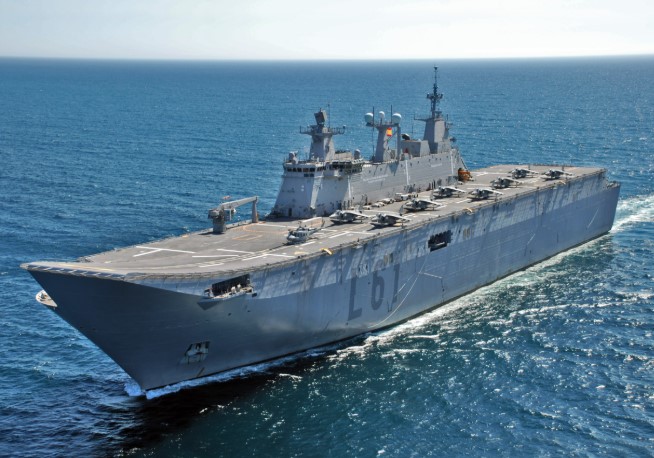Spain is moving forward with an ambitious plan to build its first conventional aircraft carrier. This major project is being led by the Spanish Navy, which aims to operate between 25 and 30 combat aircraft from the new ship.
Inspired by France’s Charles de Gaulle, But Not Nuclear-Powered
Officials have confirmed that the design will be similar to the Charles de Gaulle, the aircraft carrier used by France. However, the Spanish version will not be nuclear-powered.
The Charles de Gaulle is known for its size and strength. It is about 261 meters long, with a beam of 64 meters, and stands 75 meters tall. When fully loaded, it weighs more than 42,500 tons. Spain’s version will be in the same category as France’s Charles de Gaulle. But it will use conventional power. This means it will not use a nuclear reactor to operate.
According to a report from EFE, the Spanish Navy has made a key decision. It has assigned Navantia to conduct a feasibility study. Navantia is a well-known Spanish shipbuilding company. The study will look at how engineers can build the aircraft carrier. It will also check if it can support planes that take off and land on a traditional runway.
Spanish Navy Changes Original Plan: From Amphibious Ships to Aircraft Carrier
Originally, the Navy had a plan for 2050. It included building three new amphibious assault ships, similar to the LHD Juan Carlos I, the largest vessel in Spain’s fleet today. These ships are versatile and can carry helicopters and short-takeoff planes like the AV-8B Harrier II. These aircraft can take off from a short runway and land vertically, which is necessary for the Juan Carlos I’s deck.
Trump’s $892B defense shake-up slashes F-35 jets, fuels drone surge in bold Indo-Pacific shift
However, the Navy has now decided to transform one of these planned ships into a full aircraft carrier. The reason? To explore other options for future fighter aircraft besides the American-made F-35. The Harrier jets that Spain currently uses are getting older and will eventually need to be replaced.
The F-35, a fifth-generation fighter jet made by Lockheed Martin in the US, is currently the only fighter jet available that can take off in a short distance and land vertically. Because of this, the Navy sees the F-35 as the only current option for use on the Juan Carlos I. However, buying F-35 jets goes against Spain’s Ministry of Defense policy, which prefers to buy Spanish or European-made military equipment.
Challenges with the F-35 and the Future of Spanish Navy & Defense
The Spanish Navy has said it needs at least 12 F-35 jets. Some reports say this number could increase to 18 units, but even then, it would be too few for Spain to expect economic benefits or industrial return from Lockheed Martin. In simple terms, Spain wouldn’t get enough in return—such as manufacturing jobs or tech-sharing—to make the deal worthwhile.
India Ditches F-35 and Su-57 Talks, Powers Ahead with Homegrown AMCA Stealth Jet
One solution being discussed is to combine the Navy’s and Air Force’s needs into a larger purchase of F-35s. Spain’s Air Force is also looking for a replacement for its aging F-18 jets. Buying more units would give Spanish companies a better chance to take part in production or supply parts. But there’s a problem: the Air Force is not in favor of the F-35, and this could delay or block the idea of a joint purchase.
In this context, the Navy’s move to build a traditional aircraft carrier is seen as a strategic shift. It opens up new options for using non-vertical takeoff jets, which are more widely available from different countries, including European ones.
Meanwhile, Cartagena will host another major event as the Navy launches the S-82 submarine, part of the new S-80 series, on July 21—18 months later than originally planned. The Navy has named the submarine Narciso Monturiol and will carefully move it into the water using a floodable dock. Once launched, the vessel will go through a series of tests—first in the harbor and later at sea, including diving to its maximum depth.
Spain’s naval plans are clearly changing. From launching new submarines to building a full-sized aircraft carrier, the country is making important decisions to shape its future military capabilities. Whether it sticks with the F-35 or chooses a different path, one thing is clear: Spain is making bold moves to ensure its Navy stays modern and ready.
